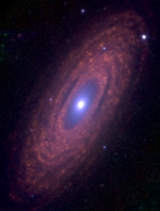
NGC 2841
Encyclopedia
NGC 2841 is an inclined unbarred spiral galaxy
in the constellation
Ursa Major. Initially thought to be about 30 million light years distant, a 2001 Hubble Space Telescope
survey of the galaxy's Cepheid variable
s determined that it was approximately 14.1 megaparsecs or 46 million light years distant. Structurally, NGC 2841 is noted for its large population of young blue stars, and few H II region
s.
(LINER), a type of region that is characterized by spectral line
emission from weakly ion
ized atoms.
Unbarred spiral galaxy
An unbarred spiral galaxy is a type of spiral galaxy without a central bar, or one that is not a barred spiral galaxy. It is designated with an SA in the galaxy morphological classification scheme.The Sombrero Galaxy is an unbarred spiral galaxy....
in the constellation
Constellation
In modern astronomy, a constellation is an internationally defined area of the celestial sphere. These areas are grouped around asterisms, patterns formed by prominent stars within apparent proximity to one another on Earth's night sky....
Ursa Major. Initially thought to be about 30 million light years distant, a 2001 Hubble Space Telescope
Hubble Space Telescope
The Hubble Space Telescope is a space telescope that was carried into orbit by a Space Shuttle in 1990 and remains in operation. A 2.4 meter aperture telescope in low Earth orbit, Hubble's four main instruments observe in the near ultraviolet, visible, and near infrared...
survey of the galaxy's Cepheid variable
Cepheid variable
A Cepheid is a member of a class of very luminous variable stars. The strong direct relationship between a Cepheid variable's luminosity and pulsation period, secures for Cepheids their status as important standard candles for establishing the Galactic and extragalactic distance scales.Cepheid...
s determined that it was approximately 14.1 megaparsecs or 46 million light years distant. Structurally, NGC 2841 is noted for its large population of young blue stars, and few H II region
H II region
An H II region is a large, low-density cloud of partially ionized gas in which star formation has recently taken place. The short-lived, blue stars forged in these regions emit copious amounts of ultraviolet light, ionizing the surrounding gas...
s.
LINER emission
NGC 2841 contains a low-ionization nuclear emission-line regionLow-ionization nuclear emission-line region
A low-ionization nuclear emission-line region is a type of galactic nucleus that is defined by its spectral line emission. The spectra typically include line emission from weakly ionized or neutral atoms, such as O, O+, N+, and S+. Conversely, the spectral line emission from strongly ionized...
(LINER), a type of region that is characterized by spectral line
Spectral line
A spectral line is a dark or bright line in an otherwise uniform and continuous spectrum, resulting from a deficiency or excess of photons in a narrow frequency range, compared with the nearby frequencies.- Types of line spectra :...
emission from weakly ion
Ion
An ion is an atom or molecule in which the total number of electrons is not equal to the total number of protons, giving it a net positive or negative electrical charge. The name was given by physicist Michael Faraday for the substances that allow a current to pass between electrodes in a...
ized atoms.

